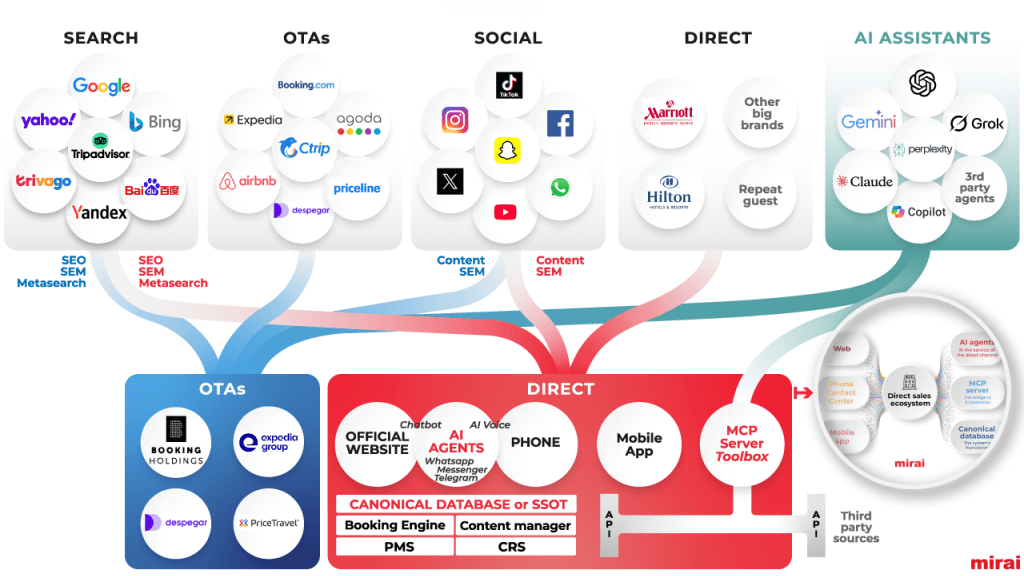
There are estimated to be more than 700,000 hotels in the world, with most of them concentrated in popular tourism hotspots. This number means that there is fierce competition to attract your guests and stand out as the one amongst 700,000 others.
NB: This is an article from SuitePad
Subscribe to our weekly newsletter and stay up to date
There are many ways to stand out: you can offer unique experiences through creative design and storytelling, conduct a competitive market analysis to offer the best value or focus narrowly on your target audience to refine your guest profile.
Before doing all of those things, though, the first step to making sure these approaches work is to have a clear understanding of where your hotel stands. This is precisely where hotel positioning becomes your best tool. We will discuss the whats and whys of hotel positioning and lay out 4 steps to master it.
What is hotel positioning, and why is it important?
Hotel positioning is the strategic process of defining and promoting your hotel’s unique attributes, target market, guest profile, and unique value propositions (UVPs) to stand out from the competition. By identifying your target audience and highlighting your hotel’s unique features like luxury service, a historical location, or family-friendly amenities, you can create a strong brand identity that appeals to your potential guests. If the positioning is defined, the messaging should be consistent. A clear positioning attracts the right guests, leading to higher satisfaction, positive feedback, and repeat bookings.
Hotel positioning is important not only for attracting guests but also for reducing costs and saving staff time. By knowing your target audience and what makes your hotel unique, you can focus your marketing efforts more precisely, avoiding wasting your resources on ineffective campaigns. Plus, a well-positioned hotel streamlines operations by aligning services with guest expectations. When your staff understand the hotel’s brand and target market, they can provide better, more targeted service, reducing time spent on unnecessary tasks.
Step 1: Defining Your Hotel’s Unique Value Proposition
The first and most important step is to define your hotel’s unique value proposition (UVP). This process involves innovative introspection and market analysis. Reflect on what sets your hotel apart. Is it your avant-garde design, personalized guest services, closeness to nature, experimental culinary experiences or a wide range of sporty activities your hotel offers? Whatever it is, ensure it aligns with your brand’s unique offerings and your guests’ expectations.
Integrate your hotel’s unique value into its positioning and seamlessly weave it into every facet of the guest experience, from marketing materials to your in-room tablets or mobile app. Your UVP is not just a statement. It’s a promise, a professional commitment to delivering an experience that your guests can’t find anywhere else. Remember, a well-defined UVP is the cornerstone of a successful positioning strategy.
A good example of a clear UVP is the Lanesborough Hotel in London. The Hotel is incorporating its unique assets into its guest experience. Located in a historical Regency-era building, the hotel enhances its Regency theme with features like tea rooms hosting Bridgerton-themed tea parties and in-room tablets designed to match the Regency aesthetic. This thoughtful definition of its UVP immerses guests in the hotel’s unique charm, making them feel part of its special atmosphere.
Step 2: Defining Your hotel’s Target Audience
The next step is to gain a deep, insightful understanding of your target audience. It’s about being helpful and tailoring your services to meet the specific needs and desires of your guests. Are they business travellers seeking efficiency and comfort, or are they leisure seekers looking for relaxation?
The process of defining your target audience for a hotel positioning strategy involves several key steps. First, run a comprehensive market research to understand industry trends and analyze competitors. Next, segment your potential guests into groups based on demographics, geography, psychographics, and behaviour. Develop detailed customer personas for each segment, such as “Business Barbara,” a 40-year-old corporate executive who travels frequently for work, values efficient service, and needs amenities like high-speed Wi-Fi and meeting rooms; “Family Frank,” a 35-year-old father who prioritizes family-friendly activities and kid-friendly amenities; and “Eco-conscious Emma,” a 28-year-old millennial who seeks sustainable and eco-friendly travel options, values hotels with green certifications, and prefers organic, locally-sourced food.




